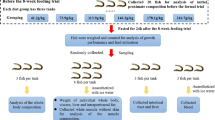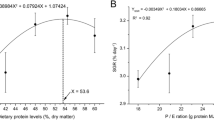Abstract
Relationships between dietary lipid source, stress, and oxidative stress were examined in juvenile chinook salmon (Oncorhynchus tshawytscha). Four different experimental diets were used: menhaden oil (MHO; elevated 20:5n-3 and 22:6n-3), soybean oil (SBO; elevated 18:2n-6), linseed oil (LSO; elevated 18:3n-3), and a mixture of 55% linseed oil and 45% soybean oil (MIX; approximately equal levels of 18:2n-6 and 18:3n-3). Juvenile salmon (initial body weight of 16.0 g) were fed experimental diets for 12 weeks (early March to early June). At the end of feeding, fish subjected to a low-water stressor for 96 h had greater liver and brain lipid peroxidation compared to unstressed controls; peroxidation was not influenced by diet. Diet and stress affected plasma cortisol levels. Stressed fish fed SBO had the greatest cortisol concentrations, followed by MIX, MHO, and LSO (mean concentrations for the SBO and LSO diets differed significantly). The cortisol response to stress may have been influenced by the ratio of prostaglandin 1- and 2-series to prostaglandin 3-series precursor fatty acids provided by the different diets. The results of this study suggest a connection between the physiological response to stress, dietary lipid quality, and oxidative stress. This is the first evidence of such a relationship in fish.
Abbreviations: AA - arachidonic acid; ACTH - adrenocorticotropin; BHT - butylated hydroxytoluene; BLPO - brain lipid peroxidation; dGLA - dihomo-γ-linolenic acid; DHA - docosahexanoic acid; EPA - eicosapentanoic acid; FER - feed efficiency ratio; FOX - ferrous oxidation-xylenol orange; GLA -γ-linolenic acid; LA - linoleic acid; LCO3 - long-chain n-3 polyunsaturated fatty acids; LLPO - liver lipid peroxidation; LN - linolenic acid; LPO - lipid peroxidation; LSO - linseed oil; MHO - menhaden oil; MIX - 55% linseed oil + 45% soybean oil; PC - plasma cortisol; PG - prostaglandin(s); PGE2- prostaglandin E2; PUFA - polyunsaturated fatty acid; SBO - soybean oil.
Similar content being viewed by others
References
Ashton, I., Clements, K., Barrow, S.E., Secombes, C.J. and Rowley, A.F. 1994. Effects of dietary fatty acids on eicosanoid-generating capacity, fatty acid composition and chemotactic activity of rain-bow trout (Oncorhynchus mykiss) lecocytes. Biochim. Biophys. Acta. 1214: 253-262.
Bell, J.G. and Cowey, C.B. 1985. Roles of vitamin E and selenium in the prevention of pathologies related to fatty acid oxidation in salmonids. In: Nutrition and feeding in fish, pp. 333-347. Edited by Cowey, C.B., Mackie, A.M., and Bell, J.G. Academic Press, London.
Bell, J.G., McVicar, A.H., Park, M.T., and Sargent, J.R. 1991. High dietary linoleic acid affects the fatty acid compositions of individual phospholipids from tissues of Atlantic salmon (Salmo salar): association with stress susceptibility and cardiac lesion. J. Nutr. 121: 1163-1172.
Bell, J.G., Tocher, D.R., and Sargent, J.R. 1994a. Effect of sup-plementation with 20:3(n-6), 20:4(n-6), and 20:5(n-3) on the production of prostaglandin E and F of the 1-, 2-, and 3-series in turbot (Scophthalmus maximus) brain astroglial cells in primary culture. Biochim. Biophys. Acta. 1211: 335-342.
Bell, J.G., Ghioni, C. and Sargent, J.R. 1994b. Fatty acid com-positions of 10 freshwater invertebrates which are natural food organisms of Atlantic salmon parr (Salmo salar): a comparison with commercial diets. Aquacult. 128: 301-313.
Bell, J.G., Tocher, D.R., Farndale, B.M., Cox, D.I., McKinney, R.W., and Sargent, J.R. 1997. The effect of dietary lipid on polyunsaturated fatty acid metabolism in Atlantic salmon (Salmo salar) undergoing parr-smolt transformation. Lipids. 32(5): 515-525.
Bell, J.G., Henderson, R.J., Tocher, D.R., McGhee, F., Dick, J.R., Porter, A., Smullen, R.P., and J.R. Sargent. 2002. Substituting fish oil with crude palm oil in the diet of Atlantic salmon (Salmo salar) affects muscle fatty acid composition and hepatic fatty acid metabolism. J. Nutrit. 132: 222-230.
Bindoli, A., Rigobello, M.P., and Deeble, D.J. 1992. Biochemical and toxicological properties of the oxidation products of catecholamines. Free Rad. Biol. Med. 13: 391-405.
Bondarenko, N.A., Devyatkina, T.A., Voskresenskii, O.N. and Val'dman, A.V. 1985. Effect of chronic emotional stress on the state of lipid peroxidation in tissue and blood of emotional and unemotional rats. Bull. Exp. Biol. Med. 100(7): 12-14.
Bugajski, J., Gadek-Michalska, A., Borycz, J., Głód and Bugajski, A.J. 1996. Effect of indomethacin on the pituitary-adrenocortical response to adrenergic stimulation. Life Sci. 59(14): 1157-1164.
Burat, K.M. and Bozkurt, O. 1996. Improvement of calibration curve for determining peroxide values of food lipids by the modified ferrous oxidation-xylenol orange method. J. AOAC Int. 79(4): 995-997.
Calder, P.C. 1998. Dietary fatty acids and the immune system. Nutr. Rev. 56(1): S70-S83.
Chen, I.S., Shen, C.-S. and Shepherd, A.J. 1981. Comparison of methylene chloride and chloroform for the extraction of fats from food products. J. Am. Oil Chem. Soc. 58: 599-601.
Cohen, J. 1988. Statistical power analysis for behavioral sciences, 2nd ed. Hillsdale, N.J. Earlbaum.
Dalla Via, J., Villani, P., Gasteiger, E. and Niederstätter, H. 1998. Oxygen consumption in sea bass fingerling Dicentrarchus labrax exposed to acute salinity and temperature changes: metabolic basis for maximum stocking density estimations. Aquacult. 169: 303-313.
Folch, J., Lees, M., and Sloane-Stanley, G.H. 1957. A simple method for the isolation and purification of total lipids from animal tissues. J. Biol. Chem. 226: 497-509.
Frings, C.S., Fendley, T.W., Dunn, R.T., and Queen, C.A. 1972. Improved determination of total serum lipids by the sulfo-phospho-vanillin reaction. Clin. Chem. 18(7): 673-674.
Gulyaeva, N.V., Luzina, N.L., Levshina, I.P. and Kryzhanovskii G.N. 1988. Stage of inhibition of lipid peroxidation during stress. Bull. Exp. Biol. Med. 106(12): 660-663.
Gupta, O.P., Lahlou, B., Botella, J. and Porthé-Nibelle, J. 1985. In vivo and in vitro studies on the release of cortisol from inter-renal tissue in trout. I. Effects of ACTH and prostaglandins. Exp. Biol. 43: 201-212.
Klontz, G.W., Downey, P.C., and Focht, R.L. 1980. Feeding rate calculations for salmon and trout. Aquacult. Mag. Jul/Aug, 29-31.
Liu, J. and Mori, A. 1999. Stress, aging, and brain oxidative damage. Neurochem. Res. 24: 1479-1497.
Liu, J., Wang, X., Shigenaga, M.K., Yeo, H.C., Mori, A. and Ames, B.N. 1996. Immobilization stress causes oxidative damage to lipid, protein, and DNA in the brain of rats. FASEB J. 10: 1532-1538.
Murata, H. and Yamauchi, K. 1989. Relationship between the 2-thiobarbituric acid values of some tissues from cultured red sea bream and its dietary á-tocopherol levels. Nipp. Suis. Gakk. 55(8): 1435-1439.
Nishigori, H., Lee, J.W., Iwamoto, Y., Hayashi, R., Maruyama, K. and Iwatsuru, M. 1984. Alteration of hepatic lipidperoxide levels during cataract formation caused by glucocorticoids in developing chick embryos. Life Sci. 35: 981-985.
Olsen, R.E. and Henderson, R.J. 1997. Muscle fatty acid com-position and oxidative stress indices of Arctic char (Sulvelinus ulpinus L.) in relation to dietary polyunsaturated fatty acid levels and temperature. Aquacult. Nutrit. 3: 227-238.
Olsen, R.E., Løvaas, E. and Lie, Ø. 1999. The influence of temperature, dietary polyunsaturated fatty acids, á-tocopherol and spermine on fatty acid composition and indices of oxidat-ive stress in juvenile Arctic char, Salvelinus alpinus (L.). Fish Physiol. Biochem. 20: 13-29.
Saito, M. 2000. Dietary docosahexanoic acid does not promote tissue lipid peroxide formation to the extent expected from the peroxidizability index of the lipids. Biofactors. 13(1-4): 15-24.
Sekhar, B.S., Krup, C.K.R. and Ramasarma, T. 1990. Increase in hepatic microsomal lipid peroxidation mediated by â-adrenergic system under cold stress and noradrenaline treatment. Molec. Cell. Biochem. 94: 61-70.
Shantha, N.C. and Decker, E.A. 1994. Rapid, sensitive, iron-based spectrophotometric methods for determination of peroxide values of food lipids. J. AOAC Int. 77(2): 421-424.
Sloman, K.A., Motherwell, G., O'Connor, K.I. and Taylor, A.C. 2000. The effect of social stress on the standard metabolic rate (SMR) of brown trout, Salmo trutta. Fish Physiol. Biochem. 23: 49-53.
Smith, W.L. 1989. Review article: the eicosanoids and their bio-chemical mechanisms of action. Biochem. J. 259: 315-324.
Stéphan, G., Guillaume, J. and F. Lamour. 1995. Lipid peroxida-tion in turbot (Scophthalmus maximus) tissue: effect of dietary vitamin E and dietary n-6 or n-3 polyunsaturated fatty acids. Aquacult. 130: 251-268.
Tocher, D.R., Bell, J.G., Dick, J.R., Henderson, R.J., McGhee, F., Michell, D. and Morris, P.C. 2000. Polyunsaturated fatty acid metabolism in Atlantic salmon (Salmo salar) undergoing parr-smolt transformation and the effects of dietary linseed and rapeseed oils. Fish Physiol. Biochem. 23: 59-73.
Tucker, B.W., Tolbert, B.M., Halver, J.E., and Balaban, M. 1987. Brain ascorbate depletion as a response to stress. Int. J. Vitam. Nutr. Res. 57(3): 289-295.
Turunen, S. 1988. Uptake of dietary lipids: a novel pathway in Pieris brassicae. Insect Biochem. 18(5): 499-505.
Tverdokhlib, V.P., Shmakova, E.N., Blazheevich, N.V., Meerson, F.Z., and Spirichev, V.B. 1987. Effect of emotional and pain stress on the level of antioxidant vitamins in the blood serum of rats. Vopr. Pitan. Nov-Dec (6): 52-54.
Van Handel, E. 1985. Rapid determination of total lipids in mosqui-toes. J. Am. Mosq. Control Assoc. 1(3): 302-304.
Wales, N.A.M. 1988. Hormone studies in Myxine glutinosa: effects of the eicosanoids arachidonic acid, prostaglandin E1,E2,A2,F2α, thromboxane B2 and of indomethacin on plasma cortisol, blood pressure, urine flow and electrolyte balance. J. Comp. Physiol. B. 158: 621-626.
Welker, T.L. and Congleton, J.L. 2004. Oxidative stress in ju-venile chinook salmon, Oncorhynchus tshawytscha (Walbaum). Aquacult. Res. 35: 881-887.
Author information
Authors and Affiliations
Rights and permissions
About this article
Cite this article
Welker, T.L., Congleton, J.L. Relationship between dietary lipid source, oxidative stress, and the physiological response to stress in sub-yearling chinook salmon (Oncorhynchus tshawytscha). Fish Physiology and Biochemistry 29, 225–235 (2003). https://doi.org/10.1023/B:FISH.0000045724.93156.ef
Issue Date:
DOI: https://doi.org/10.1023/B:FISH.0000045724.93156.ef




